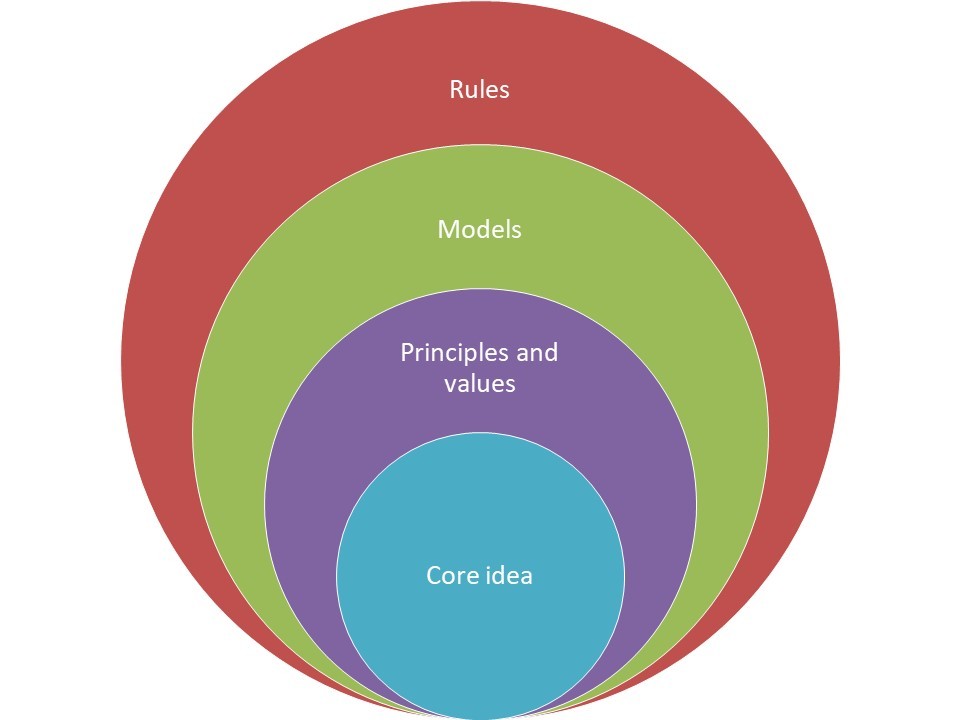In reflecting on various approaches to expressing the design of our enterprises, I have discovered an interesting common pattern as to how we provide guidance to the ongoing evolution of the design and its realisation. This article describes the background to learning about each approach and the common pattern between them.
Knowledge Ecology Workgroup
In the late 90’s, I was a member of a global, online community exploring how to articulate and engage others in understanding the generation and sharing of knowledge through the lens of knowledge ecology.
As part of the group, Mike McMasters introduced an approach to “defining an organisation” based around articulating its essence through four themes:
- Core idea
- Principles and values
- Models
- Rules
The core idea conveys the essence of what the organisation is about and around which the organisation revolves, so to speak.
Principles and values are those held dear to the organisation and which reflect and guide the manner in which the organisation thinks, make decisions and behaves.
Models reflect the manner in which the organisation will operate.
Rules are key policies that act as guidance to the manner in which the organisation will operate.
These were seen as the minimalist set of guidance that would adequately describe an enterprise and give it the freedom to innovate and leverage the resources, particularly its people and their knowledge, to the greatest benefit to the organisation.
 Economic Development Advisor
Economic Development Advisor
In that same period, I worked with Tim Waterhouse in the South Australian Development Council, which was established to provide advice to the Government on economic development strategies. Our role was to further develop strategies for building a strong and vibrant IT industry, expanding on the IT 2000 strategies that the government has established in the mid 90’s.
Tim operated on the basis that if we shared the same vision and values, then he was confident I would make similar decisions to him in whatever circumstances I might find myself, enabling us to be involved in more activities individually, and achieving broader coverage and engagement.
I would add to this that we also shared a number of common models which underpinned our thinking and understanding of the South Australian economy and of approaches to developing a stronger and broader economy, the IT industry as an enabling industry, and government as an anchor customer.
Latest articulation of approach
In a recent article, I have explored (a little) around the vision and purpose of enterprises, and have been reflecting on the need for such statements. I have wondered whether a vision or statement of purpose is required or whether it can be derived from the business model and business strategy? I am aware that there are significant challenges in crafting a useful vision or statement of purpose (but that does not mean it should not be done). I am also aware that there are benefits in expressing the core motivation for the enterprise.
Several comments were made about the “positioning” of vision at the commencement of the approach. In a subsequent revision, I left the vision element out. Yet, there does seem to be a need for expressing the motivation for the enterprise, perhaps as that element which provides the energy, life and inspiration for pursuing the enterprise.
In reflecting on the “core idea” from my Knowledge Ecology Workgroup experience, I can see that this is essentially the expression of vision and purpose in that particular approach.
Common pattern
From these different experiences, it is probably pretty evident that the common pattern looks quite like the model outlined by Mike McMasters in the following visual.

This seems to align closely with the core elements of expressing the intended architecture of an enterprise, providing guidance to the ongoing design of a self-organising, self-designing, self-realising enterprise.
Article by channel:
Everything you need to know about Digital Transformation
The best articles, news and events direct to your inbox
Read more articles tagged: Featured, Operating Model






